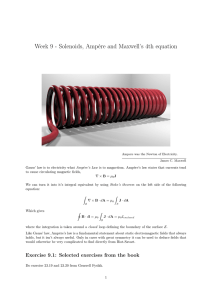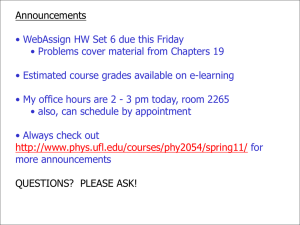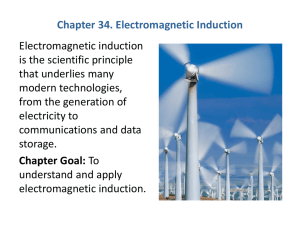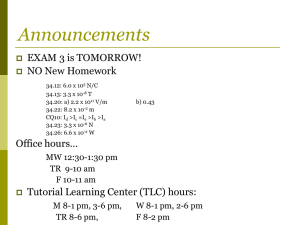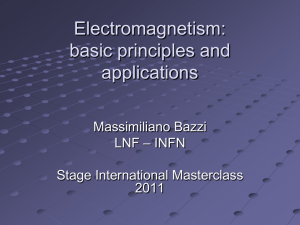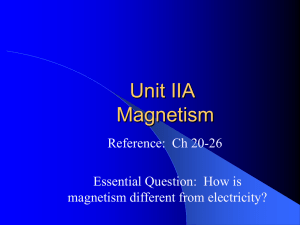21.2 Electromagnetism
advertisement
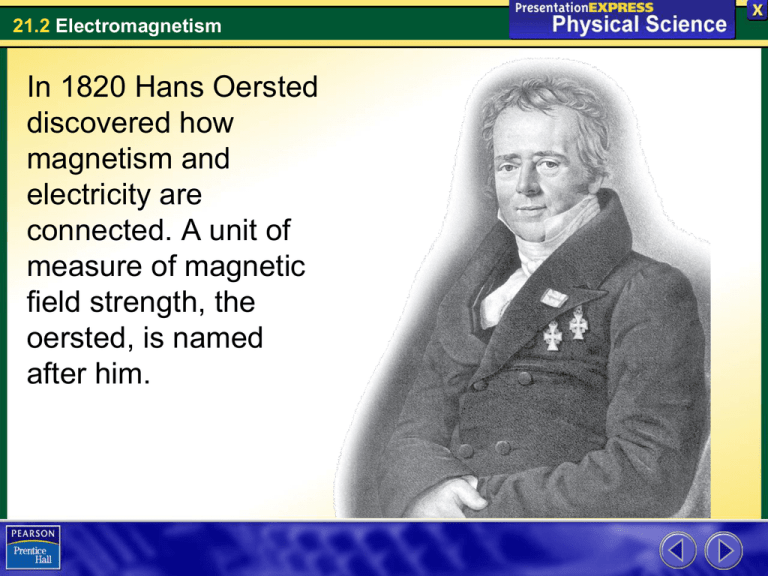
21.2 Electromagnetism In 1820 Hans Oersted discovered how magnetism and electricity are connected. A unit of measure of magnetic field strength, the oersted, is named after him. 21.2 Electromagnetism Electricity and Magnetism How can an electric charge create a magnetic field? Moving electric charges create a magnetic field. 21.2 Electromagnetism Electricity and Magnetism Electricity and magnetism are different aspects of a single force known as the electromagnetic force. • The electric force results from charged particles. • The magnetic force usually results from the movement of electrons in an atom. 21.2 Electromagnetism Electricity and Magnetism Magnetic Fields Around Moving Charges Moving charges create a magnetic field. • Moving charges may be the vibrating charges that produce an electromagnetic wave or the moving charges in a wire. • Magnetic field lines form circles around a straight wire carrying a current. 21.2 Electromagnetism Electricity and Magnetism If you point the thumb of your right hand in the direction of the current, your fingers curve in the direction of the magnetic field. Direction of current Direction of electron flow Current-carrying wire Direction of magnetic field 21.2 Electromagnetism Electricity and Magnetism Forces Acting on Moving Charges A magnetic field exerts a force on a moving charge. • A charge moving in a magnetic field is deflected in a direction perpendicular to both the field and to the velocity of the charge. • A current-carrying wire in a magnetic field will be pushed in a direction perpendicular to both the field and the direction of the current. 21.2 Electromagnetism Electricity and Magnetism • Reversing the direction of the current will still cause the wire to be deflected, but in the opposite direction. • If the current is parallel to the magnetic field, the force is zero and there is no deflection. 21.2 Electromagnetism Electricity and Magnetism A moving positive charge is deflected at a right angle to its motion by a magnetic field. Force deflecting the charge Velocity of charge 21.2 Electromagnetism Solenoids and Electromagnets How is an electromagnet controlled? Changing the current in an electromagnet controls the strength and direction of its magnetic field. 21.2 Electromagnetism Solenoids and Electromagnets If a current-carrying wire has a loop in it, the magnetic field in the center of the loop points right to left through the loop. Multiple loops in the wire make a coil. The magnetic fields of the loops combine so that the coiled wire acts like a bar magnet. 21.2 Electromagnetism Solenoids and Electromagnets The field through the center of the coil is the sum of the fields from all the turns of the wire. A coil of current-carrying wire that produces a magnetic field is called a solenoid. 21.2 Electromagnetism Solenoids and Electromagnets The magnetic field lines around a solenoid are like those of a bar magnet. 21.2 Electromagnetism Solenoids and Electromagnets If a ferromagnetic material, such as an iron rod is placed inside the coil of a solenoid, the strength of the magnetic field increases. • The magnetic field produced by the current causes the iron rod to become a magnet. • An electromagnet is a solenoid with a ferromagnetic core. • The current can be used to turn the magnetic field on and off. 21.2 Electromagnetism Solenoids and Electromagnets The strength of an electromagnet depends on the current in the solenoid, the number of loops in the coil, and the type of core. The strength of an electromagnet can be increased using the following methods. • Increase the current flowing through the solenoid. • Increase the number of turns. • Use cores that are easily magnetized. 21.2 Electromagnetism Electromagnetic Devices How do galvanometers, electric motors, and loudspeakers work? Electromagnetic devices such as galvanometers, electric motors, and loudspeakers change electrical energy into mechanical energy. 21.2 Electromagnetism Electromagnetic Devices Electromagnets can convert electrical energy into motion that can do work. • A galvanometer measures current in a wire through the deflection of a solenoid in an external magnetic field. • An electric motor uses a rotating electromagnet to turn an axle. • A loudspeaker uses a solenoid to convert electrical signals into sound waves. 21.2 Electromagnetism Electromagnetic Devices Galvanometers A galvanometer is a device that uses a solenoid to measure small amounts of current. • A solenoid is attached to a spring and is free to rotate about an iron core. • The solenoid is placed between the poles of two permanent magnets. 21.2 Electromagnetism Electromagnetic Devices • A current in the solenoid’s coils produces a magnetic field that attempts to align with the field of the permanent magnets. • The greater the current, the more the solenoid rotates. 21.2 Electromagnetism Electromagnetic Devices A galvanometer uses an electromagnet to move a pointer. One common application is in an automobile gas gauge. The pointer indicates the current in the wire. The wire is connected to a sensor in the gas tank. 21.2 Electromagnetism Electromagnetic Devices Electric Motors An electric motor is a device that uses an electromagnet to turn an axle. • A motor has many loops of wire around a central iron core. • In the motor of an electric appliance, the wire is connected to an electrical circuit in a building. 21.2 Electromagnetism Electromagnetic Devices 21.2 Electromagnetism Electromagnetic Devices In this motor, a battery supplies current to a loop of wire through the commutator. When current flows through a loop of wire, the field of the permanent magnet pushes one side of the loop. The other side of the loop is pulled. These forces rotate the loop. • If there were no commutator ring, the coil would come to rest. • As the loop turns, each C-shaped half of the commutator connects with a different brush, reversing the current. • The forces now change direction, so the coil continues to rotate. As long as current flows, rotation continues. 21.2 Electromagnetism Electromagnetic Devices Loudspeakers A loudspeaker contains a solenoid placed around one pole of a permanent magnet. The current in the wires entering the loudspeaker changes direction and increases or decreases. 21.2 Electromagnetism Electromagnetic Devices The changing current produces a changing magnetic field in the solenoid coil. The magnetic force exerted by the permanent magnet moves the coil back and forth. As the coil moves, it causes a thin membrane to vibrate, producing sound waves that match the original sound. 21.2 Electromagnetism Assessment Questions 1. A charged particle is moving across a plane from left to right as it enters a magnetic field that runs from top to bottom. How will the motion of the particle be changed as it enters the magnetic field? a. b. c. d. It will accelerate. It will deflect either up or down on the plane. It will deflect perpendicular to the plane. Its motion will not be affected. 21.2 Electromagnetism Assessment Questions 1. A charged particle is moving across a plane from left to right as it enters a magnetic field that runs from top to bottom. How will the motion of the particle be changed as it enters the magnetic field? a. b. c. d. It will accelerate. It will deflect either up or down on the plane. It will deflect perpendicular to the plane. Its motion will not be affected. ANS: C 21.2 Electromagnetism Assessment Questions 2. Which change will increase the strength of an electromagnet made by wrapping a conductive wire around an iron nail? a. b. c. d. reversing the direction of current flow replacing the nail with a wooden dowel increasing the number of coils of wire around the nail using a longer nail 21.2 Electromagnetism Assessment Questions 2. Which change will increase the strength of an electromagnet made by wrapping a conductive wire around an iron nail? a. b. c. d. reversing the direction of current flow replacing the nail with a wooden dowel increasing the number of coils of wire around the nail using a longer nail ANS: C 21.2 Electromagnetism Assessment Questions 3. A loudspeaker uses a magnet to cause which energy conversion? a. b. c. d. mechanical energy to magnetic energy electrical energy to mechanical energy electrical energy to magnetic energy mechanical energy to electrical energy 21.2 Electromagnetism Assessment Questions 3. A loudspeaker uses a magnet to cause which energy conversion? a. b. c. d. mechanical energy to magnetic energy electrical energy to mechanical energy electrical energy to magnetic energy mechanical energy to electrical energy ANS: B 21.2 Electromagnetism Assessment Questions 1. The motion of an electric charge creates an electrical field. True False 21.2 Electromagnetism Assessment Questions 1. The motion of an electric charge creates an electrical field. True False ANS: F, a magnetic
